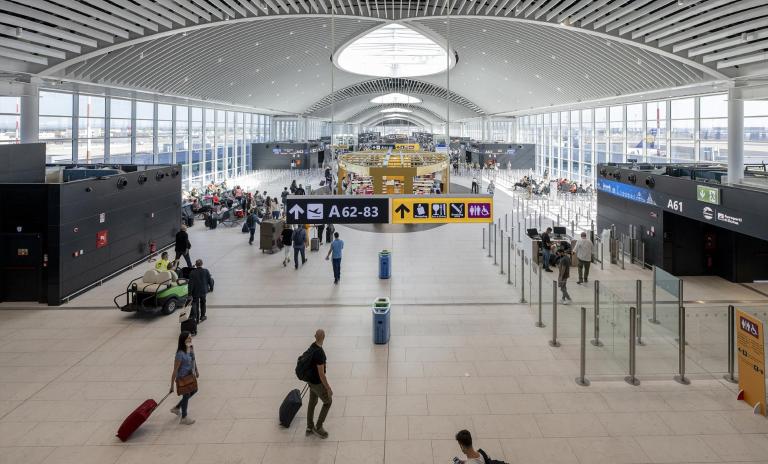Aerospace & Defense
Roland Berger advises the aerospace, defense and security industries. We support OEMs, suppliers, agencies and investors.


As part of our studies and projects on the environment in the aviation ecosystem, Roland Berger is conducting a series of interviews with companies who are building the ecological future of the airport industry. Read more in our interview with Marco Troncone and his team from Aeroporti Di Roma (ADR).
"The really big challenge is to sensitize all the industry players, financial sponsors and adjacent industry players to invest now and do whatever it takes to try to match short term sustainability and net zero goals."
What is ADR's vision of the airport's role in decarbonization? And more broadly in terms of environmental, social and governance responsibility?
ADR is willing to be a thought leader on sustainability among European airports: in net zero in particular and ESG topics in general. Our purpose is not only to draft and deliver initiatives but to lead the whole industry by example, orchestrating a real and concrete change in mindset.
ADR is positioned among the frontrunners. We were the first airport in Europe to reach ACA4+ certification of the ACI. With this, we have a clear commitment to scope 3. A concrete action plan is in place to bring our emissions to 0 by 2030. When we declared this goal there were not more than a dozen airports committing to it. That commitment was also set in stone in order to avoid any misunderstandings and greenwashing in this respect. We issued innovative sustainability-linked bonds and were the first airport to do so – entailing a potential increase in our cost of debt based on certain sustainability targets.
We aimed at increasing the level of credibility of our commitment through a financial instrument, bought by a number of institutional investors who then own a legal right to monitor closely your actual progress and intervene in the event that you do not deliver the sustainability results.
We have an ambitious 100m+ CAPEX spending plan for the next 5 years – the challenge for an airport is less technological than financial.
Our sector needs to embark on a virtuous path, like others are doing, otherwise the market may punish us, both customers and financial backers. We have a responsibility to respect public opinion – sooner than we expect, people will think twice before flying based on sustainability concerns.
What environmental initiative(s) have you recently launched at your airport?
Scopes 1 and 2 are relatively easy to tackle for an airport – we've activated several levers:
Scope 3 is accessible to a good degree:
Which partnerships in the airport ecosystem do you consider particularly important to improve the environmental footprint? And more specifically, to aim towards zero carbon?
We have built numerous partnerships on many sustainability aspects:
What is your roadmap for the future?
The roadmap for the future is focused on the next 3-4 years, as we are careful to focus on short- to medium-term perspectives.
We are not sure that at the global/system level net zero objectives will be met by all stakeholders. So it will be crucial for the aviation industry to be prepared and show the maximum level of proactivity. Otherwise, they risk being considered among the "dirty" industries, with similar implications as for tobacco. If aviation is considered an industry that is heavily restricted, a vicious circle will be in place whereby the sector will be of reduced magnitude and less money will be available to make it cleaner.
Aviation is not included in the NextGenerationEU funds. Alternatives must be found now in order to change the inertia. Tons of CO2 will increase as volumes rebound, which may result in more restrictions and more taxes, penalizing the sector. The only way out is to encourage players to invest increased proceeds from growth in the ecological transition, with the maximum level of urgency.
ADR is worried about the potential context evolution in the short to medium term. If expectations are poorly managed it will then be too late: public opinion will be negative, propensity to fly will be dramatically reduced, restrictive laws will be rapidly promulgated, talents will abandon the industry…
…it will be a mess with a really difficult, almost impossible, path to recovery.
What are your next biggest challenges?
ADR is pushing for other ESG topics, like gender gap, equity, inclusion – but the really big challenge is to sensitize all the industry players, financial sponsors and adjacent industry players to invest now and do whatever it takes to try to match short-term sustainability and net zero goals.
In summary, ADR believes the priorities are:
Today is the day. ADR's role from now on will be not just to communicate a "list of initiatives" we are launching, but also to tell the market things they don't want to hear and make stakeholders open their eyes – screaming about the urgency to move/change.
The risk of weakening the industry's competitiveness, and being considered the worst performer, is really too high.
Being relevant now and managing expectations for tomorrow will be the one and only way through.
Register now to receive regular insights into Aerospace & Defense topics.
